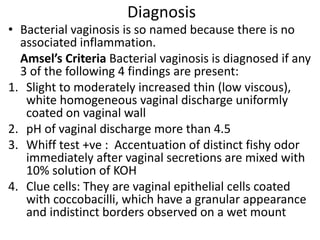Bacterial Vaginosis & Gonococcal infection.pptx
- 1. Bacterial Vaginosis & Gonococcal Infection. Dr Shan
- 2. Bacterial Vaginosis ? Bacterial vaginosis affects women of reproductive age. This condition is associated with an alteration of the normal vaginal flora, which is as follows: ? ? Increase in the concentrations of: - ? Gardnerella vaginalis: It is normally isolated from the female genital tract in low numbers; but in bacterial vaginosis, it outnumbers other organisms ? - Mobiluncus (motile, curved, gram-variable or gramnegative, anaerobic rods) ? - Several other anaerobes (Prevotella and some Peptostreptococcus) ? - Mycoplasma hominis ? Decrease in the concentrations of lactobacilli (lactobacilli maintain the acidic pH of the vagina
- 3. Risk Factors ? Bacterial vaginosis can occur in presence of the following risk factors: ? ? Coexisting other infections such as HIV, Chlamydia trachomatis, and Neisseria gonorrhoeae ? ? Recent unprotected vaginal intercourse ? Vaginal douching ? ? Premature rupture of membranes and preterm labor.
- 4. Diagnosis ? Bacterial vaginosis is so named because there is no associated inflammation. Amsel¡¯s Criteria Bacterial vaginosis is diagnosed if any 3 of the following 4 findings are present: 1. Slight to moderately increased thin (low viscous), white homogeneous vaginal discharge uniformly coated on vaginal wall 2. pH of vaginal discharge more than 4.5 3. Whiff test +ve : Accentuation of distinct fishy odor immediately after vaginal secretions are mixed with 10% solution of KOH 4. Clue cells: They are vaginal epithelial cells coated with coccobacilli, which have a granular appearance and indistinct borders observed on a wet mount
- 6. Laboratory Diagnosis ? ? Nugent¡¯s score: It is a scoring system followed for the diagnosis of bacterial vaginosis; done by counting the number of G.vaginalis, Mobiluncus and lactobacilli present in the Gram stained smear of vaginal discharge. ? A score of more than or equal to 7 is diagnostic Score Lactobacillus Score 0-4 Gardnerella Score 0-4 Mobiluncus Score 0-2 0 > 30 / OIF 0 0 1 5-30 / OIF < 1 / OIF 1-4 /OIF 2 1-4 / OIF 1-4 / OIF > 5 /OIF 3 < 1 / OIF 5-30 / OIF 4 0 > 30 / OIF
- 7. ? Culture: G. vaginalis requires enriched media such as chocolate agar, BHI broth with serum, etc. ? - It is gram-negative (appears gram-variable in smears), nonmotile, small pleomorphic rod, which shows metachromatic granules ? - It produces minute hemolytic colonies on blood agar, incubated aerobically under 5% CO2 for 24¨C48 hours - Identification from colonies is made either by conventional biochemical tests or by automated identification systems such as MALDI-TOF or VITEK
- 9. Neisseria gonorrhoeae ? Noncapsulated, gram- negative kidney-shaped diplococcus. ? It causes ¡®gonorrhea¡¯, a sexually transmitted infection (STI) which commonly manifests as cervicitis, urethritis and conjunctivitis.
- 10. Virulence Factors 1.? Pili or fimbriae: Help in adhesion to host cells and prevent bacteria from phagocytosis ? 2. Outer membrane proteins: ? ? Porin (protein I): ? Transmembrane channels (pores) which help in exchange of molecules across gonococcal surface ? There are two major serotypes: PorB.1A and PorB.1B serotypes. ? Opacity-associated protein (Protein II): Helps in adhesion to neutrophils and other gonococci. 3. Transferrin-binding and lactoferrinbinding proteins, 4. IgA1 protease 5. lipo-oligosaccharide (LOS) with endotoxin
- 11. Laboratory Diagnosis ? Specimen Collection: - Urethral swab in men and cervical swab in women are the preferred specimens. - Dacron or rayon swabs are preferred, as cotton and alginate swabs are inhibitory to gonococci ? Transport Media: Stuart¡¯s transport medium or Amies medium. ? Microscopy: Gram staining of urethral exudates reveals gram- negative intracellular kidney-shaped diplococci ? Culture: Thayer Martin medium ? Identification: Gonococci are catalase and oxidase positive ? They ferment only glucose, but not maltose and sucrose ? Automated systems such as MALDI-TOF can be used. ? Molecular Method: PCR targeting 16s or 23s rRNA gene.











